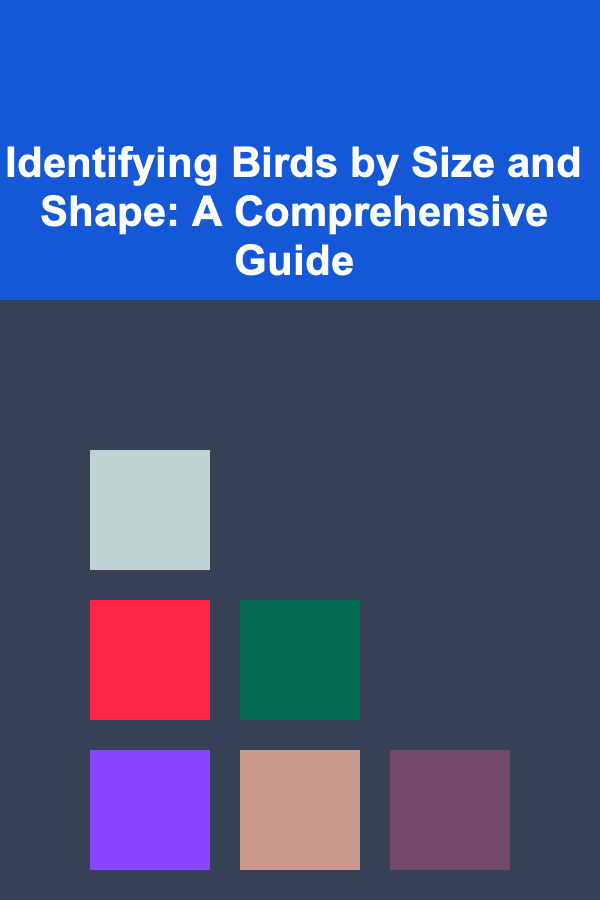
Identifying Birds by Size and Shape: A Comprehensive Guide
ebook include PDF & Audio bundle (Micro Guide)
$12.99$10.99
Limited Time Offer! Order within the next:

Bird identification can seem daunting at first, but with practice and the right tools, it becomes a rewarding skill. While color and markings are often the first things that catch our eye, relying solely on these can be misleading. Variations in lighting, age, and plumage can significantly alter a bird's appearance. Instead, focusing on size and shape provides a more reliable foundation for identification. These characteristics are less susceptible to environmental variations and often provide crucial clues, especially when combined with habitat, behavior, and vocalizations.
Understanding the Importance of Size and Shape
Size and shape, often referred to collectively as "structure" or "jizz" (a British term for the overall impression of a bird), are fundamental to bird identification. They provide a consistent framework that transcends temporary variations in plumage. By learning to recognize basic shapes and understand relative sizes, you can quickly narrow down the possibilities and focus on more specific characteristics.
Think of it like recognizing people. You might recognize someone by their height and build even before seeing their face clearly. The same principle applies to birds. Is it a compact, robin-sized bird, or a large, soaring raptor? Is it slender with a long tail, or stocky with a short tail? These initial observations are key to unlocking the bird's identity.
Relative Size: A Foundation for Comparison
Instead of trying to estimate precise measurements (which is difficult in the field), focus on comparing the bird's size to familiar objects or other birds. This is known as relative size. Here's a useful scale:
- Smaller than a Sparrow: Examples include kinglets, gnatcatchers, and some warblers.
- Sparrow-sized: A common and useful benchmark. House Sparrows, Chipping Sparrows, and Song Sparrows are good examples.
- Robin-sized: Another common reference point. American Robins, Eastern Bluebirds, and some thrushes fall into this category.
- Grackle-sized: Larger than a robin, but still smaller than a crow. Common Grackles, Brown Thrashers, and some woodpeckers are examples.
- Crow-sized: A familiar large bird. American Crows, Ravens (slightly larger), and some hawks are in this category.
- Duck-sized: A general category encompassing various duck species. Mallards are a common reference.
- Goose-sized: Even larger than a duck. Canada Geese and Snow Geese are examples.
- Larger than a Goose: Relatively rare, but includes swans, cranes, and some larger raptors.
When observing a bird, try to quickly categorize its size relative to these familiar benchmarks. For example, you might say, "It's about the size of a robin, but much more slender." This narrows the field considerably.
Important Note: Region matters! A "sparrow-sized" bird in one area might be a very different species than a "sparrow-sized" bird in another. Consider your geographic location when making size comparisons.
Beyond Relative Size: Paying Attention to Proportions
While relative size is important, proportions add another layer of detail. How long is the tail relative to the body? How thick is the beak? How long are the legs? These proportions provide critical clues for distinguishing between similar-sized species.
Consider two birds both described as "robin-sized": an Eastern Phoebe and a Wood Thrush. The Phoebe is typically more slender with a longer tail, while the Wood Thrush is more robust with a shorter tail. Observing these subtle differences in proportion is key to accurate identification.
Key Aspects of Bird Shape to Observe
Bird shape is a complex combination of several factors. Here's a breakdown of the key features to focus on:
1. Body Shape: Overall Impression
The overall body shape gives you a first impression of the bird's silhouette. Is it:
- Round and compact: Think of wrens or bushtits.
- Slender and streamlined: Examples include swallows, flycatchers, and some warblers.
- Stocky and robust: Sparrows, finches, and some thrushes often have a more robust build.
- Elongated and tubular: Hummingbirds and some kingfishers have this shape.
Consider the bird's posture as well. Does it stand upright, perch horizontally, or creep along branches? These behavioral aspects contribute to the overall impression of body shape.
2. Beak Shape: A Window into Diet
The beak is a crucial identifying feature, and its shape is directly related to the bird's diet. Consider these common beak types:
- Thin and pointed: Ideal for probing for insects. Warblers, vireos, and gnatcatchers often have this type of beak.
- Conical and stout: Perfect for cracking seeds. Finches, sparrows, and grosbeaks possess these strong beaks.
- Hooked: Used for tearing flesh. Hawks, eagles, owls, and shrikes all have hooked beaks.
- Long and decurved: Designed for probing flowers or extracting insects from crevices. Hummingbirds, some thrashers, and curlews have this type of beak.
- Spatulate (spoon-shaped): Used for sifting through mud or water. Ducks like Northern Shovelers have spatulate beaks.
- Chisel-like: Used for drilling into wood. Woodpeckers are the primary example.
- Pouch-like: Used for scooping up fish. Pelicans are the classic example.
Beyond the basic shape, also consider the beak's length relative to the head. Is it very long, very short, or proportional?
A bird with a short, stout, conical beak is likely a seed-eater, narrowing down the possibilities to finches, sparrows, or grosbeaks. A bird with a long, thin, slightly decurved beak might be a hummingbird or a probing warbler.
3. Wing Shape: Flight Style Revealed
Wing shape is a strong indicator of a bird's flight style and habitat. Observe the wings at rest and in flight.
- Long and pointed: Designed for fast, direct flight. Swallows, falcons, and shorebirds often have these wings.
- Short and rounded: Adapted for maneuverability in dense vegetation. Grouse, quail, and some forest-dwelling birds have this wing shape.
- Long and broad: Ideal for soaring and gliding. Hawks, eagles, vultures, and albatrosses possess these wings.
- Elliptical: A versatile shape suitable for a variety of flight styles. Many songbirds have elliptical wings.
Also consider the wingspan relative to the body size. A bird with a disproportionately large wingspan is likely a soaring species.
In flight, pay attention to how the bird holds its wings. Does it soar effortlessly, flap continuously, or alternate between flapping and gliding?
4. Tail Shape: Steering and Balance
The tail acts as a rudder, providing steering and balance during flight. Tail shape varies considerably and is a useful identification feature.
- Long and pointed: Swallows and some raptors (like Sharp-shinned Hawks) often have pointed tails.
- Long and forked: Common in swallows and some terns, providing excellent maneuverability.
- Long and rounded: Often seen in thrushes, catbirds, and other perching birds.
- Short and square: Many sparrows and other small perching birds have square tails.
- Short and rounded: Wrens and bushtits often have short, rounded tails.
- Wedge-shaped: Some woodpeckers and raptors (like Northern Harriers) have wedge-shaped tails.
- Graduated: The tail feathers gradually increase in length from the outer to the central feathers. Brown Creepers have this distinctive tail shape.
Also note how the bird holds its tail. Does it cock it upwards, wag it constantly, or keep it held straight?
5. Leg Length: Habitat Adaptation
Leg length reflects a bird's foraging habits and habitat preferences.
- Long legs: Wading birds like herons, egrets, and shorebirds have long legs for foraging in shallow water.
- Short legs: Birds that spend most of their time in trees or shrubs, such as warblers and finches, often have shorter legs.
- Moderately long legs: Birds that forage on the ground, like robins and thrushes, typically have legs of moderate length.
Pay attention to the color of the legs and feet as well. Leg color can be a useful identifying feature in some species.
Putting it All Together: A Step-by-Step Approach
Identifying birds by size and shape requires a systematic approach. Here's a suggested process:
- Initial Observation: Before focusing on details, take a quick overall impression. Where is the bird? What is it doing? What's the general habitat (forest, field, wetland)?
- Size Estimation: Compare the bird to familiar objects or other birds to estimate its relative size (smaller than a sparrow, robin-sized, crow-sized, etc.).
- Body Shape Assessment: Determine the overall body shape (round, slender, stocky, elongated). Note the bird's posture.
- Beak Analysis: Observe the beak shape and size, relating it to the bird's likely diet.
- Wing Shape Examination: Analyze the wing shape (long and pointed, short and rounded, long and broad) and its relation to flight style.
- Tail Shape Identification: Identify the tail shape (long and pointed, forked, square, rounded, wedge-shaped) and how the bird holds its tail.
- Leg Length Consideration: Assess the leg length in relation to foraging habits and habitat.
- Integration with Other Clues: Combine your observations of size and shape with other clues, such as color patterns (if visible), behavior, vocalizations, and geographic location.
- Consult Field Guides: Use field guides to compare your observations with the characteristics of possible species. Pay attention to the range maps to eliminate species that are not found in your area.
Common Mistakes and How to Avoid Them
Even experienced birders make mistakes. Here are some common pitfalls to avoid when relying on size and shape:
- Ignoring Habitat: Size and shape are most useful when combined with habitat information. A robin-sized bird in a forest is likely a different species than a robin-sized bird on a beach.
- Underestimating Variation: There can be individual variation within a species. Age, sex, and geographic location can all influence size and shape.
- Poor Lighting Conditions: Poor lighting can distort your perception of size and shape. Try to get a clear view of the bird in good light.
- Relying Solely on One Feature: Never rely solely on size or shape. Use a combination of features for accurate identification.
- Lack of Practice: Bird identification is a skill that improves with practice. Spend time observing birds and practicing your identification skills.
- Getting Frustrated: Don't get discouraged if you can't identify every bird. Enjoy the process of learning and observing nature.
Advanced Techniques: Identifying Birds in Flight
Identifying birds in flight presents a unique set of challenges. Size and shape become even more important because color patterns are often difficult to discern.
Focus on the following aspects when identifying birds in flight:
- Flight Style: Does the bird flap continuously, soar effortlessly, or alternate between flapping and gliding?
- Wingbeat Frequency: Is the wingbeat fast or slow? Shallow or deep?
- Overall Silhouette: Note the overall shape of the bird in flight, including the wing shape, tail shape, and body proportions.
- Flocking Behavior: Does the bird fly alone or in a flock? If in a flock, what is the flock formation?
Learn to recognize the flight patterns of common bird groups, such as raptors, waterfowl, shorebirds, and swallows. Each group has characteristic flight styles that can aid in identification.
Resources for Further Learning
There are many excellent resources available to help you improve your bird identification skills:
- Field Guides: A good field guide is essential. Choose one that covers your geographic region and includes detailed information on size, shape, color, behavior, and habitat.
- Online Resources: Websites like All About Birds (Cornell Lab of Ornithology) and Audubon offer extensive information on bird identification.
- Birding Apps: Mobile apps like Merlin Bird ID and iBird Pro can help you identify birds in the field.
- Birding Clubs: Join a local birding club to learn from experienced birders and participate in field trips.
- Workshops and Courses: Attend bird identification workshops and courses offered by nature centers and educational institutions.
Conclusion
Mastering the art of bird identification by size and shape is a journey that requires patience, practice, and a keen eye for detail. By focusing on these fundamental characteristics, you can unlock a deeper understanding of the avian world and enjoy the endless rewards of birding. Remember to combine your observations with other clues, such as habitat, behavior, and vocalizations, for the most accurate identifications. Happy birding!

How to Ensure Accessibility for All Guests at Your Event
Read More
How to Incorporate DIY Decor into Your Home Without the Stress
Read More
How To Master Video SEO for YouTube
Read More
How to Provide Counseling and Coaching Services to Clients: An Actionable Guide
Read More
How To Research Ancient Egyptian Funerary Texts
Read More
How To Master Your Character Through Stoic Habits
Read MoreOther Products

How to Ensure Accessibility for All Guests at Your Event
Read More
How to Incorporate DIY Decor into Your Home Without the Stress
Read More
How To Master Video SEO for YouTube
Read More
How to Provide Counseling and Coaching Services to Clients: An Actionable Guide
Read More
How To Research Ancient Egyptian Funerary Texts
Read More